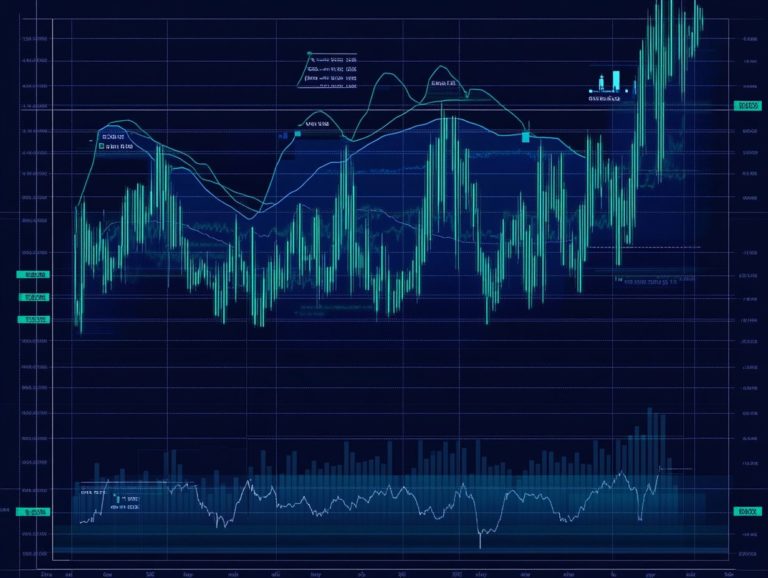Understanding the Psychology of Market Trends
In today’s fast-paced business landscape, staying ahead demands a sharp understanding of market trends.
This article delves into the multifaceted nature of these trends, uncovering the economic, social, and technological factors that shape them. You ll explore the psychology behind consumer behavior and decision-making. Arm yourself with tools and techniques for analyzing market movements.
Discover how to transform these insights into actionable strategies that can propel your business to success. Learn from real-life case studies of companies that have flourished by embracing change.
Get ready to uncover the secrets of market trends that can transform your business!
Contents
- Key Takeaways:
- Factors Influencing Market Trends
- The Psychology Behind Market Trends
- Predicting and Analyzing Market Trends
- Utilizing Market Trends for Business Success
- Frequently Asked Questions
- What is the psychology behind market trends?
- How do emotions play a role in market trends?
- Can cognitive biases affect market trends?
- What role does social influence play in market trends?
- How can understanding market psychology be beneficial for investors?
- Is market psychology a reliable predictor of future trends?
Key Takeaways:

- Understanding market trends is key to your business success. They reflect the economic, social, and technological elements influencing consumer choices.
- Consumer behavior is shaped by emotions, biases, and social influences at play.
- To stay competitive, companies must analyze trends using effective tools and techniques.
Defining Market Trends and Their Importance
Market trends are essential indicators in financial markets. They reflect the collective behavior and sentiment of investors.
By understanding these trends, you enable yourself to make informed decisions while navigating the complexities of market dynamics. Analyzing price action and employing technical analysis which looks at past market data to predict future movements allow you to discern patterns that often lead to profitable opportunities.
Grasping the psychology behind market trends is vital for developing robust trading strategies. Understanding the role of market sentiment enhances your comprehension of market anomalies and shifts in consumer behavior.
You can identify these trends through various technical indicators, such as moving averages, momentum oscillators, and support and resistance levels. Each serves as a crucial tool for predicting future price movements.
For instance, a sudden spike in trading volume might signal a significant shift in sentiment. This is often driven by emotional biases that can either push prices upward or trigger abrupt corrections.
Investor psychology plays a pivotal role in these dynamics. Fear and greed can lead to market anomalies that distort the perceived value of assets. By incorporating insights from sentiment analysis and understanding these psychological factors, you can navigate the often unpredictable landscape of financial trading with greater confidence.
Factors Influencing Market Trends
Market trends are shaped by a multitude of factors, including economic indicators, social influences, and psychological elements. All of these significantly impact investor sentiment and crowd behavior.
Economic indicators like GDP growth and unemployment rates serve as barometers of investor confidence. Social influence can either amplify or temper market movements through herd mentality and emotional biases.
Behavioral finance provides valuable insights into how these psychological factors inform decision-making processes, ultimately influencing the dynamics of the market.
Economic, Social, and Technological Factors
Economic, social, and technological factors are essential for you to grasp market trends. They significantly influence both investor sentiment and trading strategies.
For example, when you analyze economic indicators, fluctuations in consumer spending often reveal confidence or apprehension in the economy. This may prompt you to reassess your positions. High inflation rates may push you to be more cautious, favoring safer assets. Strong employment data usually boosts market optimism and encourages you to invest in growth stocks.
On the social side, shifts in consumer behavior like the heightened demand for sustainable products can directly impact company stock values and market strategies. Brands that adapt to these trends tend to attract loyal buyers, making them more appealing investments.
Technological advancements, such as computer-assisted trading and the rise of trading apps, not only boost trading volumes but also enable you, the individual investor, to act quickly. This pushes markets in exciting new directions.
These factors create a dynamic trading environment where your sentiment as an investor is constantly tested and reshaped.
The Psychology Behind Market Trends

The psychology behind market trends is a fascinating and intricate dance of investor sentiment, emotional biases, and crowd behavior. It significantly shapes financial decision-making. Understanding market psychology is crucial for you as a trader or investor because it reveals emotional forces that can lead to irrational market movements and heightened volatility.
Behavioral finance shows how biases like overconfidence or loss aversion impact your trading strategies. These biases can give rise to market anomalies. By diving into these psychological dynamics, you can enhance your ability to anticipate market trends and refine your investment decisions for optimal outcomes.
Behavioral Economics and Decision Making
Behavioral economics explores the psychological factors that influence your decision-making processes in financial markets. It underscores the significance of emotional intelligence and risk perception. By grasping how cognitive biases and emotional triggers shape your investment choices, you gain valuable insights into market psychology and the collective behavior of other market participants.
These insights can be pivotal in crafting trading strategies that accommodate irrational behaviors. This ultimately enhances the effectiveness of your investment decisions.
This field reveals how individuals often stray from acting in their own best interests. They are swayed instead by emotions like fear and greed. Take loss aversion, for example a prevalent cognitive bias that can lead to overly cautious behavior, causing you to miss out on golden opportunities.
Emotional intelligence equips you to navigate market volatility more adeptly. This enables you to make calmer, more reasoned decisions even when the market is in a frenzy.
Understanding these dynamics is essential for both individual investors and financial professionals. It helps in developing strategies aligned with behavioral finance principles, ultimately refining decision-making processes in the face of complexity.
Predicting and Analyzing Market Trends
Predicting and analyzing market trends requires you to harness a range of market indicators, technical analysis tools, and sentiment analysis techniques. These are essential to interpret price action and trading volume with precision.
By scrutinizing price charts and essential technical indicators, you can uncover patterns and signals that may indicate potential market movements. This analytical method sharpens your decision-making skills and enables you to craft robust trading strategies that align with the ever-evolving market dynamics.
Tools and Techniques for Market Analysis
Market analysis tools include various trading indicators. These help you evaluate price action and understand market sentiment.
These analytical resources are essential. They provide critical insights into price movements and the forces that drive market fluctuations.
Among the most commonly utilized tools are moving averages, the relative strength index (RSI), and Bollinger Bands. These tools collectively help you identify optimal entry and exit points.
By studying these indicators, you can assess overbought or oversold conditions, revealing potential trading opportunities.
Incorporating broader market indicators, such as volume and open interest, gives you a comprehensive view of market dynamics. Ultimately, leveraging these tools not only helps you isolate strong trading signals but also fosters a deeper understanding of overall market trends.
Utilizing Market Trends for Business Success

Utilizing market trends for your business success means harnessing insights into trading strategies, consumer behavior, and brand loyalty. Brand loyalty means customers consistently choosing your brand over others.
When you grasp these trends, you can refine your offerings and marketing strategies. This ultimately boosts customer involvement and drives sales.
By remaining attuned to shifts in consumer preferences and behaviors, you position yourself to seize emerging opportunities. At the same time, you can effectively mitigate the risks tied to market volatility.
Strategies for Adapting to Market Changes
Strategies for adapting to market changes require a keen understanding of market dynamics. You must assess risk perception among various consumer segments.
Employ trading strategies that do more than just react to immediate market shifts; they should also anticipate future trends influenced by emotional factors and consumer behavior.
Segment the market to identify distinct groups. This approach allows for tailored messaging that resonates with your targeted consumers.
Leveraging data analytics is essential to gauge shifts in consumer sentiment and preferences, enabling you to pivot effectively when needed.
Incorporating feedback loops can foster continuous improvement and innovation. This makes your brand more resilient in the face of uncertainty.
Stay tuned to market changes and focus on emotional connections. This approach helps you reduce risks and grab new opportunities, keeping your business relevant.
Case Studies of Successful Companies
Case studies of successful companies provide invaluable insights into effectively leveraging market trends. These insights can elevate your trading strategies while enhancing consumer behavior and brand loyalty.
Whether through innovative marketing tactics or distinctive product offerings, successful companies exhibit a sharp awareness of evolving market trends and consumer preferences.
Take, for instance, a renowned tech giant that adapted its product line in response to shifting consumer demands for sustainability. By incorporating eco-friendly materials and spotlighting these changes in its marketing efforts, the company attracted a new audience and deepened its connections with existing customers.
This approach not only bolstered brand loyalty but also positioned the company as a leader in responsible innovation.
In the retail sector, consider how a fashion brand reshaped its inventory to align with fast-fashion trends. This agile response enhanced customer engagement and drove increased sales.
These examples reveal how understanding market dynamics can drive your business success don’t miss out!
Frequently Asked Questions
What is the psychology behind market trends?

The psychology of market trends involves psychological factors affecting investor behavior. Emotions, biases, and cognitive processes influence decision-making and contribute to market movements.
How do emotions play a role in market trends?
Emotions like fear, greed, and hope heavily influence investor behavior. For instance, fear can lead to stock selling, causing a market decline.
Can cognitive biases affect market trends?
Cognitive biases are thinking errors that lead to irrational choices. For example, availability bias makes investors overestimate familiar events, affecting market trends.
Social influence shapes market trends. When many investors support a trend, it can create a ripple effect, steering the market in a specific direction.
How can understanding market psychology be beneficial for investors?
Understanding market psychology helps investors make informed choices. By recognizing their emotions and biases, they can avoid impulsive decisions that may hurt their investments.
Is market psychology a reliable predictor of future trends?
Market psychology offers insights but isn t a guaranteed predictor of future trends. Economic conditions and company performance also play critical roles.






